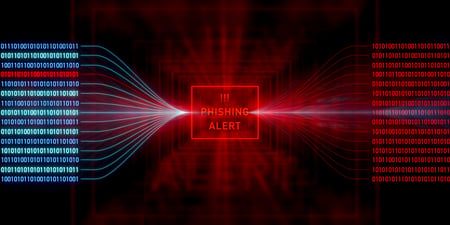Struggling to Prevent Sophisticated Phishing Scams? Here’s What You Can Do
Phishing scams have evolved far beyond simple email fraud. Cybercriminals now use AI-powered phishing attacks, deepfake impersonations, and highly targeted social engineering tactics to trick employees into revealing sensitive information. These scams not only compromise data security but also lead to financial losses, operational disruptions, and reputational damage. To protect your organization, it is essential to implement advanced phishing prevention strategies that go beyond traditional security measures.
Why Traditional Email Security Measures Are No Longer Enough to Stop Modern Phishing Attacks
Many businesses still rely on spam filters and basic email authentication to block phishing attempts. However, attackers are now leveraging AI and automation to craft realistic emails that bypass these defenses. Sophisticated phishing campaigns use techniques like domain spoofing, link obfuscation, and real-time website cloning to deceive employees. Without an adaptive, multi-layered security approach, organizations remain vulnerable to these evolving threats.
Did You Know?
Did you know that 75% of cyberattacks start with a phishing email, and AI-generated phishing scams have increased by 126% in the past year?
Proven Phishing Prevention Strategies to Safeguard Your Organization
1. AI-Driven Email Security Detects and Blocks Phishing Emails Before They Reach Inboxes
AI-powered email security solutions analyze sender behavior, email content, and metadata to detect phishing attempts that bypass traditional filters. By using machine learning models, these systems can identify malicious patterns and flag suspicious emails in real time, reducing the risk of human error.
2. Multi-Factor Authentication (MFA) Prevents Unauthorized Account Access Even if Credentials Are Stolen
Implementing MFA adds an extra layer of security by requiring employees to verify their identity with a secondary authentication method. This ensures that even if an attacker obtains login credentials through phishing, they cannot access sensitive systems without additional verification.
3. Advanced Threat Intelligence Provides Real-Time Updates on Emerging Phishing Techniques
Organizations should integrate threat intelligence feeds that provide real-time insights into the latest phishing scams, malicious domains, and cybercriminal tactics. By staying ahead of attackers, businesses can proactively block known phishing sources before an attack occurs.
4. Security Awareness Training Empowers Employees to Identify and Report Phishing Attempts
Even the best technical defenses cannot eliminate human error. Regular phishing awareness training helps employees recognize suspicious emails, avoid clicking on malicious links, and report phishing attempts. Simulated phishing exercises can further reinforce best practices and reduce the likelihood of successful attacks.
5. Automated Incident Response Mitigates Phishing Attacks Before They Escalate
Phishing incidents require immediate action to prevent data breaches and account takeovers. Automated security systems can detect phishing attempts, quarantine malicious emails, and revoke compromised credentials, ensuring a rapid response without manual intervention.
How Phishing Prevention Strategies Enhance Cybersecurity Resilience
1. Reduced Risk of Data Breaches and Financial Fraud
Effective phishing prevention minimizes the risk of attackers stealing sensitive information, reducing financial losses and reputational damage.
2. Improved Compliance with Industry Regulations
Many cybersecurity regulations, such as GDPR and CMMC, require organizations to implement phishing prevention measures to protect user data and maintain compliance.
3. Faster Threat Detection and Response
With AI-driven security and automated response tools, phishing attempts can be identified and neutralized before they compromise systems.
4. Enhanced Employee Security Awareness
Continuous training and phishing simulations ensure that employees remain vigilant against new social engineering tactics.
5. Strengthened Organizational Cybersecurity Posture
By adopting a multi-layered phishing defense strategy, businesses can significantly reduce their exposure to phishing scams and cyber threats.
How to Implement a Comprehensive Phishing Prevention Plan
For organizations looking to strengthen phishing security, consider these steps:
- Deploy AI-Powered Email Security: Use advanced machine learning models to detect phishing attempts in real time.
- Require Multi-Factor Authentication (MFA): Implement MFA across all critical accounts to prevent unauthorized access.
- Enable Automated Incident Response: Use automation to quarantine phishing emails and disable compromised accounts immediately.
- Conduct Regular Phishing Awareness Training: Educate employees on phishing risks and conduct simulated phishing attacks.
- Leverage Threat Intelligence Feeds: Stay updated on emerging phishing tactics and block known malicious domains.
How BitLyft AIR® Provides Advanced Phishing Prevention Solutions
BitLyft AIR® offers AI-driven phishing prevention strategies that protect organizations from evolving phishing threats. With real-time email security, automated incident response, and continuous security awareness training, BitLyft AIR® helps businesses stay ahead of cybercriminals. Learn more at BitLyft AIR® Security Automation.
FAQs
Why are phishing attacks so effective?
Phishing attacks exploit human psychology and impersonate trusted entities, making them difficult to detect without advanced security measures.
How does AI improve phishing prevention?
AI analyzes email patterns, sender behavior, and metadata to detect sophisticated phishing attempts that evade traditional security filters.
What should employees do if they suspect a phishing email?
Employees should report the email to their IT security team, avoid clicking links or downloading attachments, and verify the sender’s identity.
How can businesses test their phishing defenses?
Organizations can conduct simulated phishing exercises to evaluate employee awareness and improve their phishing prevention strategies.
How does BitLyft AIR® help prevent phishing attacks?
BitLyft AIR® provides AI-powered email security, automated phishing detection, and real-time threat intelligence to protect businesses from phishing threats.





